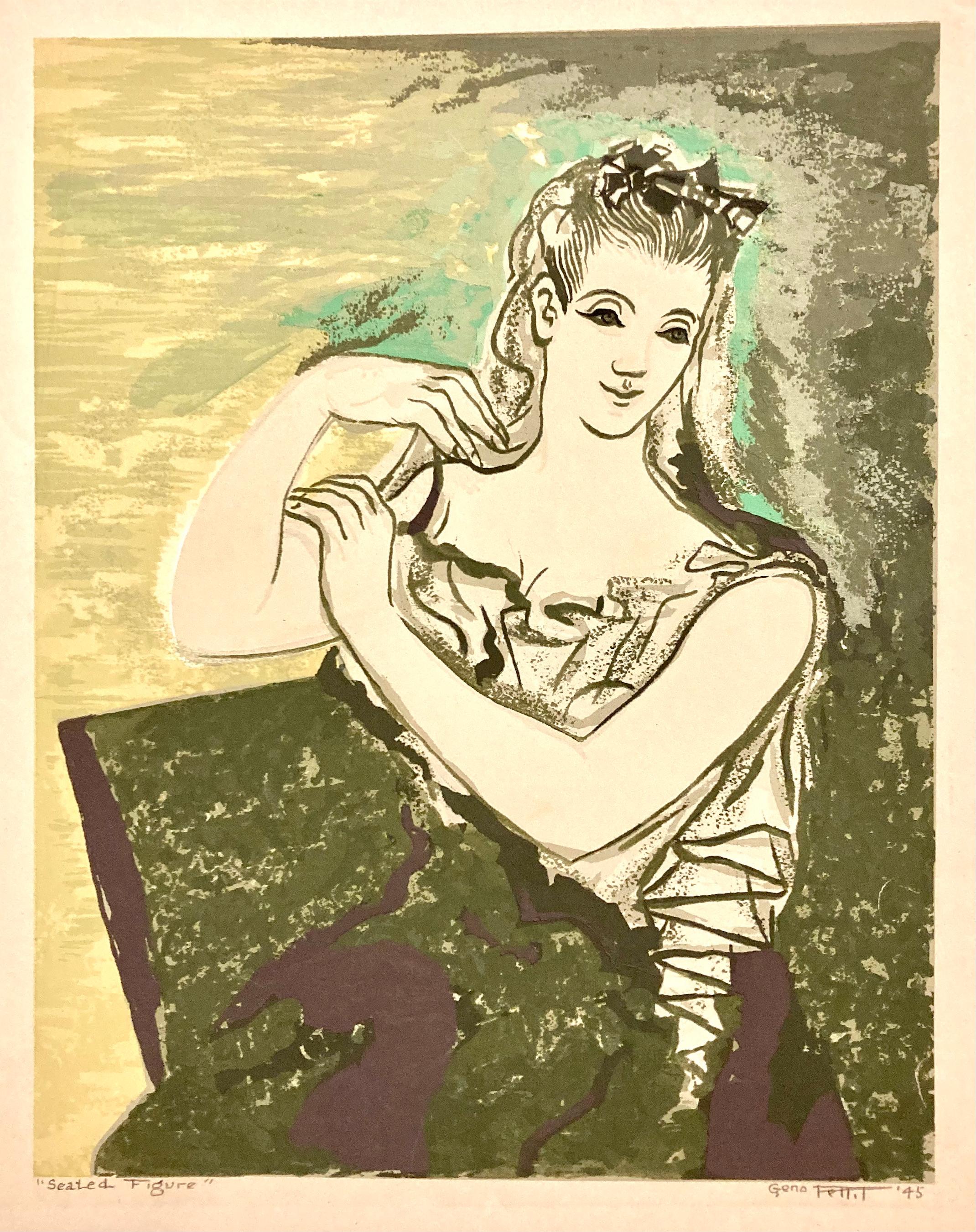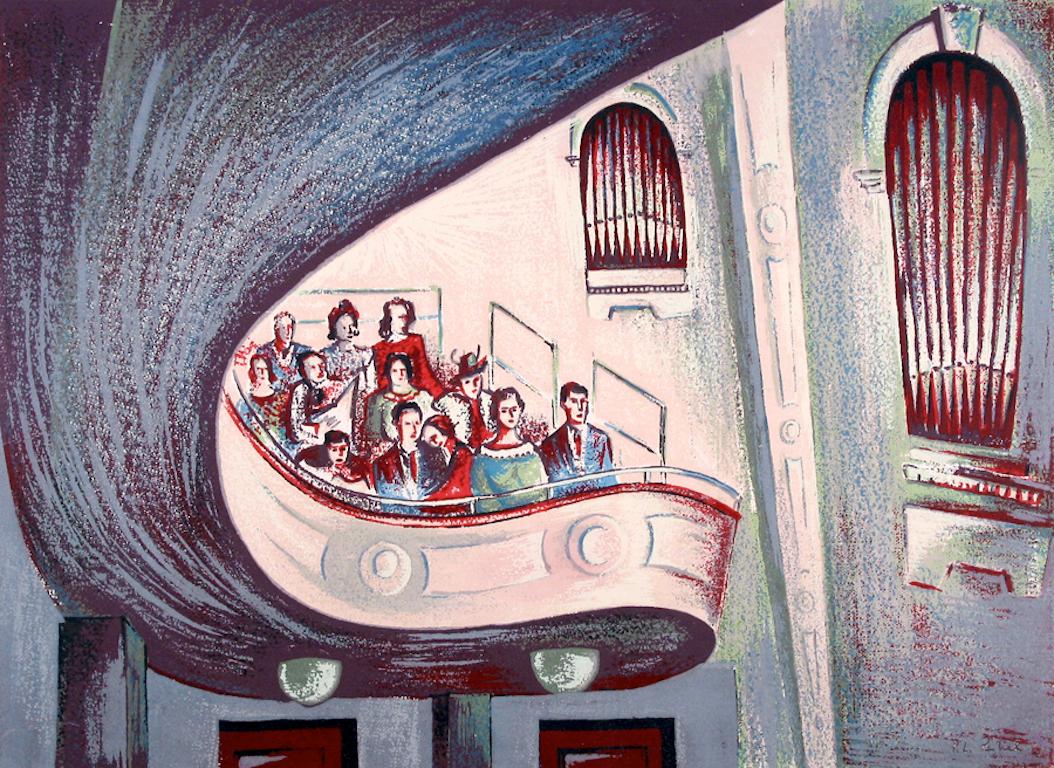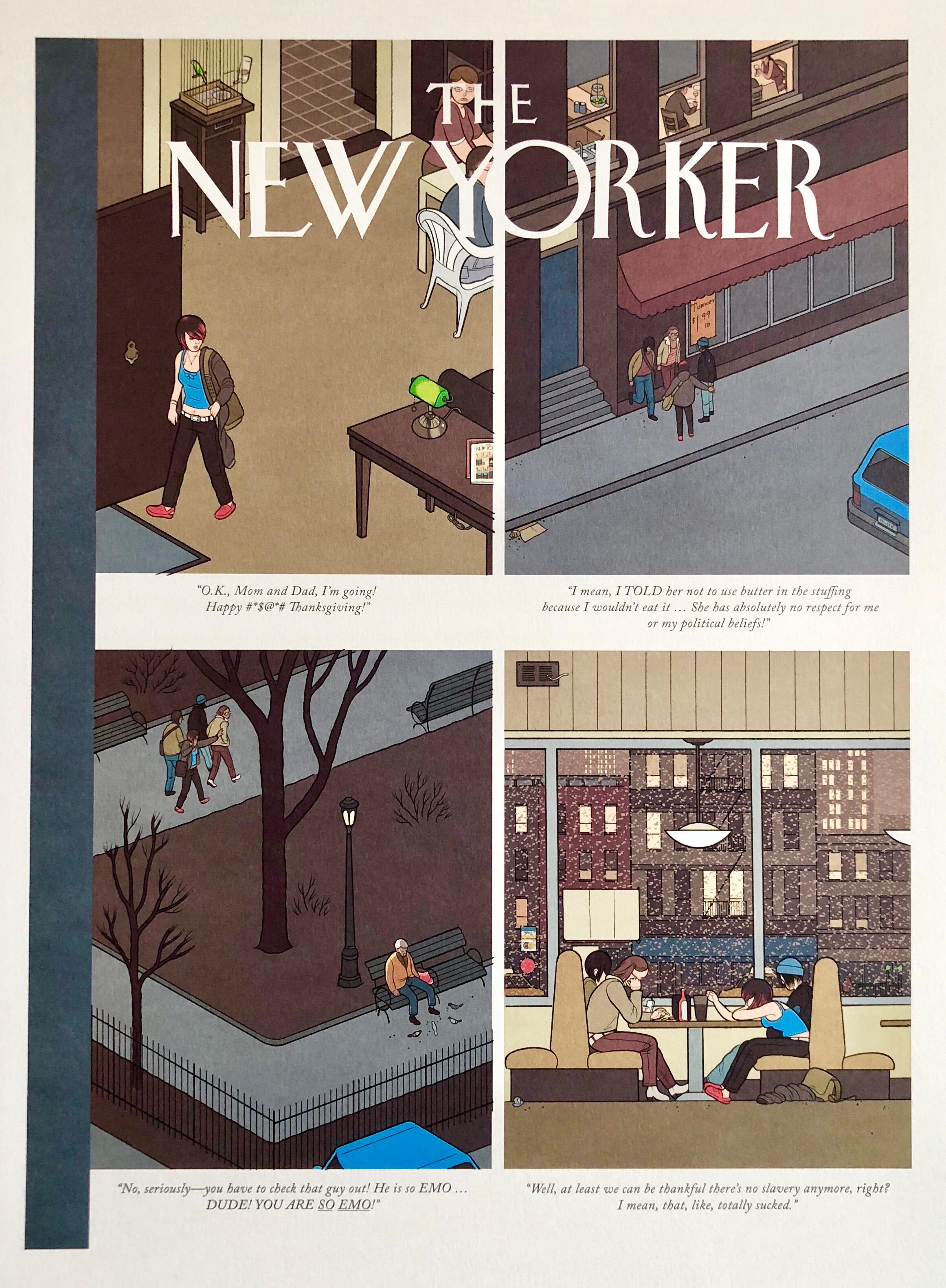Items Similar to Toast
Want more images or videos?
Request additional images or videos from the seller
Rickey Jewell HohimerToastc.1990
c.1990
About the Item
This artwork titled "Toast" c.1990, is an original color serigraph by American artist Rickey Jewell Hohimer, 1946-2021. It is hand signed, titled and numbered 98/300 in pencil by the artist. The image size is 23.75 x 9.5 inches, framed size is 30.25 x 16.25 inches. The artwork is in excellent condition, the frame is slightly damaged, and will be replaced by a new similar black frame when sold. This will bring the over all condition to excellent.
About the artist:
Although formally trained with a MFA in painting, Rickey Jewell Hohimer has used the styles of Van Gogh and Gaughin to reach for the spontaneity and simplicity of today's folk art. Hohimer creates figures which are not photos of reality; they are romantically stylized to encourage straightforward emotional responses both to the colorful images and to the situations in which they find themselves. Each of Hohimer's paintings lays out a basic story line to which viewers add their own details. "I want the viewer to become personally involved. My paintings offer a change from those which encourage extensive intellectualizing about what the artist is trying to convey. I want viewers to smile -- to enjoy the whimsical nature of what they are experiencing -- to feel it, not to analyze it. His jazz paintings are stories on canvas of inspired musicians spontaneously making music of the moment. Life in the jazz age is clubs and nightlife beckoning to musicians to produce jazz art through music. R. J. creates paintings of jazz musicians, not necessarily recognized celebrities. Rather, he captures the total environment of jazz: The music, the lights, the audience, the smoke, and the jazz music. Ah, yes, the music! It is all there-- the actual creation of jazz on canvas. Like jazz music, R.J.’s jazz art has a life of its own.
- Creator:Rickey Jewell Hohimer (1946 - 2021, American)
- Creation Year:c.1990
- Dimensions:Height: 30.25 in (76.84 cm)Width: 16.25 in (41.28 cm)Depth: 1 in (2.54 cm)
- Medium:
- Movement & Style:
- Period:
- Condition:
- Gallery Location:San Francisco, CA
- Reference Number:
About the Seller
5.0
Platinum Seller
These expertly vetted sellers are 1stDibs' most experienced sellers and are rated highest by our customers.
Established in 1999
1stDibs seller since 2017
686 sales on 1stDibs
Typical response time: 1 hour
- ShippingRetrieving quote...Ships From: San Francisco, CA
- Return PolicyA return for this item may be initiated within 7 days of delivery.
More From This SellerView All
- II Cup of JoeLocated in San Francisco, CAThis artwork titled "II Cup of Joe" c.1990, is an original color serigraph by American artist Rickey Jewell Hohimer, 1946-2021. It is hand signed, titled and numbered 250/300 in pencil by the artist. The image size is 19.5 x 23.5 inches, framed size is 26.75 x 30 inches. The artwork is in excellent condition, the frame is slightly damaged at the top, and will be replaced by a new similar black frame when sold. This will bring the over all condition to excellent. About the artist: Although formally trained with a MFA in painting, Rickey Jewell Hohimer has used the styles of Van Gogh and Gaughin to reach for the spontaneity and simplicity of today's folk art. Hohimer creates figures which are not photos of reality; they are romantically stylized to encourage straightforward emotional responses both to the colorful images and to the situations in which they find themselves. Each of Hohimer's paintings lays out a basic story line to which viewers add their own details. "I want the viewer to become personally involved. My paintings offer a change from those which encourage extensive intellectualizing about what the artist is trying to convey. I want viewers to smile -- to enjoy the whimsical nature of what they are experiencing -- to feel it, not to analyze it!. His jazz paintings are stories on canvas of inspired musicians spontaneously making music of the moment. Life in the jazz age is clubs and nightlife beckoning to musicians to produce jazz art...Category
Late 20th Century American Modern Figurative Prints
MaterialsScreen
- Two LoversBy Linda Le KinffLocated in San Francisco, CAThis artwork "Two Lovers" c.1990 is an original color serigraph by noted French artist Linda Le Kinff, born 1949. It is hand signed and numbered 40/300 in ...Category
Late 20th Century Contemporary Figurative Prints
MaterialsScreen
- Woman with CatBy Linda Le KinffLocated in San Francisco, CAThis artwork "Woman with Cat" c.1990 is an original color serigraph by noted French artist Linda Le Kinff, born 1949. It is hand signed and numbered 12...Category
Late 20th Century Contemporary Figurative Prints
MaterialsScreen
- Mujere IIBy Raul SoldiLocated in San Francisco, CAThis artwork "Mujere II" c.1960 is an original color silkscreen by noted Argentinian artist Raul Soldi, 1905-1994. It is hand signed and numbered 93/150 in pencil by the artist. The image size is 13.5 x 20.5 inches, sheet size is 19.75 x 22.75 inches. The colors are fresh and bright, it have a 0.85 inches restored tear at the lower margin (see picture #6 for detail) some paper rubs on the verso, not visible from the front. otherwise in good condition. About the artist: Raúl Soldi was born in Buenos Aire in 1905. He was an argentine plastic artist of recognized international experience. In 1920 he began drawing and painting. He makes reproductions of Quinquela Martín...Category
Mid-20th Century Expressionist Figurative Prints
MaterialsScreen
- MujereBy Raul SoldiLocated in San Francisco, CAThis artwork "Mujere" c.1960 is an original color silkscreen by noted Argentinian artist Raul Soldi, 1905-1994. It is hand signed and numbered 12/15 P.A in pencil by the artist. The image size is 22.75 x 17 inches, sheet size is 26.65 x 21.5 inches. It is in very good condition, colors are fresh and bright. About the artist: Raúl Soldi was born in Buenos Aire in 1905. He was an argentine plastic artist of recognized international experience. In 1920 he began drawing and painting. He makes reproductions of Quinquela Martín...Category
Mid-20th Century Expressionist Figurative Prints
MaterialsScreen
- Girls Seated at Desk IXBy Henry MooreLocated in San Francisco, CAArtist: Henry Moore (British, 1898-1986) Title: Girls Seated at Desk IX Year: 1974 Medium: Color lithograph Edition: Numbered 40/50 in pencil Paper: Wove Paper size: 20.25 x...Category
Late 20th Century Modern Figurative Prints
MaterialsLithograph
You May Also Like
- Angel of Hope and Strenght - Screenprint HandsignedBy Shepard FaireyLocated in Paris, FRShepard Fairey (Obey Giant) Angel of Hope and Strenght Screenprint Handsigned in pencil by the artist Dated 2020 Numbered /550 Size 61 x 46 cm (c. 24 x 18 in) Excellent conditionCategory
2010s American Modern Interior Prints
MaterialsScreen
- Geno Pettit, Seated FigureLocated in New York, NYSeated Figure by Geno (sometimes Genoi) Pettit, made in 1945, is a wonderfully 'moderne' image. The woman is wearing a roman-inspired blouse or dress and is shown against a yellow/green, chartreuse background. There is the feeling she is about to lead an ancient procession at any moment! Pettit and her husband, Guy McCoy...Category
Mid-20th Century American Modern Figurative Prints
MaterialsScreen
- Andy Gill, Anti-Hero - Screenprint HandsignedBy Shepard FaireyLocated in Paris, FRShepard Fairey (Obey Giant) Andy Gill, Anti-Hero Screenprint Handsigned in pencil by the artist Dated 2020 Numbered /400 Size 61 x 46 cm (c. 24 x 18 in) Excellent conditionCategory
2010s American Modern Interior Prints
MaterialsScreen
- "Balcony" 1938 WPA Print Mid 20th Century American Broadway Theatre ModernismBy Leon BibelLocated in New York, NY"Balcony" 1938 WPA Print Mid 20th Century American Broadway Theatre Modernism. Silk screen on paper, 15” x 20". Numbered 15/20 lower left. Pencil si...Category
1930s American Modern Figurative Prints
MaterialsPaper, Screen
- Chris Ware New Yorker Cartoonist Limited Edition Thanksgiving Print NYCBy Chris WareLocated in Surfside, FLThis is one print – printed in full color on 15" x 20" heavy cream-colored paper. It is from a limited edition series of 175, the portfolio is hand numbered and hand signed by Chris Ware. the individual prints are not. The page with the hand signature is included here as a photo for reference only it is not included in this sale. Franklin Christenson "Chris" Ware (born December 28, 1967), is an American cartoonist known for his Acme Novelty Library series (begun 1994) and the graphic novel Jimmy Corrigan, the Smartest Kid on Earth (2000) and Building Stories (2012). His works explore themes of social isolation, emotional torment and depression. He tends to use a vivid color palette and realistic, meticulous detail. His lettering and images are often elaborate and sometimes evoke the ragtime era or another early 20th-century American design style. Ware often refers to himself in the publicity for his work in self-effacing, even withering tones. He is considered by some critics and fellow notable illustrators and writers, such as Dave Eggers, to be among the best currently working in the medium; Canadian graphic-novelist Seth has said, "Chris really changed the playing field. After him, a lot of [cartoonists] really started to scramble and go, 'Holy [expletive], I think I have to try harder.'" While still a sophomore at UT, Ware came to the attention of Art Spiegelman, who invited Ware to contribute to Raw, the influential anthology magazine Spiegelman was co-editing with Françoise Mouly. Ware has acknowledged that being included in Raw gave him confidence and inspired him to explore printing techniques and self-publishing. His Fantagraphics series Acme Novelty Library defied comics publishing conventions with every issue. Ware's art reflects early 20th-century American styles of cartooning and graphic design, shifting through formats from traditional comic panels to faux advertisements and cut-out toys. Stylistic influences include advertising graphics from that same era; newspaper strip cartoonists Winsor McCay (Little Nemo in Slumberland) and Frank King (Gasoline Alley); Charles Schulz's post-WWII strip Peanuts and the cover designs of ragtime-era sheet music. Ware has spoken about finding inspiration in the work of artist Joseph Cornell and cites Richard McGuire's strip Here as a major influence on his use of non-linear narratives. He is one of the great practitioners who have elevated the graphic novel style along with, Shepard Fairey, Ben Katchor and Robert Crumb. Quimby the Mouse was an early character for Ware and something of a breakthrough. Rendered in the style of an early animation character like Felix the Cat, Quimby the Mouse is perhaps Ware's most autobiographical character. Ware's Building Stories was serialized in a host of different venues. It first appeared as a monthly strip in Nest Magazine. Installments later appeared in a number of publications, including The New Yorker, Kramer's Ergot, and most notably, the Sunday New York Times Magazine. Building Stories appeared weekly in the New York Times Magazine from September 18, 2005 until April 16, 2006. A full chapter was published in Acme Novelty Library, number 18. Another installment was published under the title "Touch Sensitive" as a digital app released through McSweeneys. The entire narrative was published as a boxed set of books by Pantheon in October 2012. Ware was commissioned by Chip Kidd to design the inner machinations of the bird on the cover of Haruki Murakami's novel The Wind-Up Bird Chronicle. In 2011, Ware created the poster for the U.S. release of the 2010 Palme d'Or winning film Uncle Boonmee Who Can Recall His Past Lives by Thai director Apichatpong Weerasethakul. Awards and honors Over the years his work garnered several awards, including the 1999 National Cartoonists Society's Award for Best Comic Book for Acme Novelty Library and Award for Graphic Novel for Building Stories. Ware has won numerous Eisner Awards and multiple Harvey Awards. In 2002, Ware became the first comics artist to be invited to exhibit at Whitney Museum of American Art biennial exhibition. With Will Eisner, Jack Kirby, Harvey Kurtzman, Robert Crumb and Gary Panter, Ware was among the artists honored in the exhibition "Masters of American Comics" at the Jewish Museum in New York City, New York, from September 16, 2006 to January 28, 2007. His work was the subject of solo exhibitions at the Museum of Contemporary Art, Chicago in 2006 and at the University of Nebraska's Sheldon Museum of Art, in 2007. Many famous artists have done covers for the New Yorker Magazine including, Saul Steinberg, Maira Kalman, Art Spiegelman, Francoise Mouly, Charles Addams, Peter Arno, Roz Chast, Ed Koren...Category
Early 2000s American Modern Figurative Prints
MaterialsColor
- Chris Ware New Yorker Cartoonist Limited Edition Thanksgiving Print NYCBy Chris WareLocated in Surfside, FLThis is one print – printed in full color on 15" x 20" heavy cream-colored paper. It is from a limited edition series of 175, the portfolio is hand numbered and hand signed by Chris Ware. the individual prints are not. The page with the hand signature is included here as a photo for reference only it is not included in this sale. Franklin Christenson "Chris" Ware (born December 28, 1967), is an American cartoonist known for his Acme Novelty Library series (begun 1994) and the graphic novel Jimmy Corrigan, the Smartest Kid on Earth (2000) and Building Stories (2012). His works explore themes of social isolation, emotional torment and depression. He tends to use a vivid color palette and realistic, meticulous detail. His lettering and images are often elaborate and sometimes evoke the ragtime era or another early 20th-century American design style. Ware often refers to himself in the publicity for his work in self-effacing, even withering tones. He is considered by some critics and fellow notable illustrators and writers, such as Dave Eggers, to be among the best currently working in the medium; Canadian graphic-novelist Seth has said, "Chris really changed the playing field. After him, a lot of [cartoonists] really started to scramble and go, 'Holy [expletive], I think I have to try harder.'" While still a sophomore at UT, Ware came to the attention of Art Spiegelman, who invited Ware to contribute to Raw, the influential anthology magazine Spiegelman was co-editing with Françoise Mouly. Ware has acknowledged that being included in Raw gave him confidence and inspired him to explore printing techniques and self-publishing. His Fantagraphics series Acme Novelty Library defied comics publishing conventions with every issue. Ware's art reflects early 20th-century American styles of cartooning and graphic design, shifting through formats from traditional comic panels to faux advertisements and cut-out toys. Stylistic influences include advertising graphics from that same era; newspaper strip cartoonists Winsor McCay (Little Nemo in Slumberland) and Frank King (Gasoline Alley); Charles Schulz's post-WWII strip Peanuts and the cover designs of ragtime-era sheet music. Ware has spoken about finding inspiration in the work of artist Joseph Cornell and cites Richard McGuire's strip Here as a major influence on his use of non-linear narratives. He is one of the great practitioners who have elevated the graphic novel style along with, Shepard Fairey, Ben Katchor and Robert Crumb. Quimby the Mouse was an early character for Ware and something of a breakthrough. Rendered in the style of an early animation character like Felix the Cat, Quimby the Mouse is perhaps Ware's most autobiographical character. Ware's Building Stories was serialized in a host of different venues. It first appeared as a monthly strip in Nest Magazine. Installments later appeared in a number of publications, including The New Yorker, Kramer's Ergot, and most notably, the Sunday New York Times Magazine. Building Stories appeared weekly in the New York Times Magazine from September 18, 2005 until April 16, 2006. A full chapter was published in Acme Novelty Library, number 18. Another installment was published under the title "Touch Sensitive" as a digital app released through McSweeneys. The entire narrative was published as a boxed set of books by Pantheon in October 2012. Ware was commissioned by Chip Kidd to design the inner machinations of the bird on the cover of Haruki Murakami's novel The Wind-Up Bird Chronicle. In 2011, Ware created the poster for the U.S. release of the 2010 Palme d'Or winning film Uncle Boonmee Who Can Recall His Past Lives by Thai director Apichatpong Weerasethakul. Awards and honors Over the years his work garnered several awards, including the 1999 National Cartoonists Society's Award for Best Comic Book for Acme Novelty Library and Award for Graphic Novel for Building Stories. Ware has won numerous Eisner Awards and multiple Harvey Awards. In 2002, Ware became the first comics artist to be invited to exhibit at Whitney Museum of American Art biennial exhibition. With Will Eisner, Jack Kirby, Harvey Kurtzman, Robert Crumb and Gary Panter, Ware was among the artists honored in the exhibition "Masters of American Comics" at the Jewish Museum in New York City, New York, from September 16, 2006 to January 28, 2007. His work was the subject of solo exhibitions at the Museum of Contemporary Art, Chicago in 2006 and at the University of Nebraska's Sheldon Museum of Art, in 2007. Many famous artists have done covers for the New Yorker Magazine including, Saul Steinberg, Maira Kalman, Art Spiegelman, Francoise Mouly, Charles Addams, Peter Arno, Roz Chast, Ed Koren...Category
Early 2000s American Modern Figurative Prints
MaterialsColor
Recently Viewed
View AllMore Ways To Browse
Retro Music Artwork
Vintage Changing Screen
C Lay
Retro Changing Screen
Toast Vintage
Vintage Style 2021
American Folk Art Screen
Jazz Folk Art
Serigraph Change
Mourlot Picasso Print
Most Expensive Item
French Erotic Art
Avant Garde 1920s
Andy Warhol And Jean Michel Basquiat
Fernand Leger Painting
Vintage Wedding Collection
Picasso 1958
Japanese Ukiyo E


